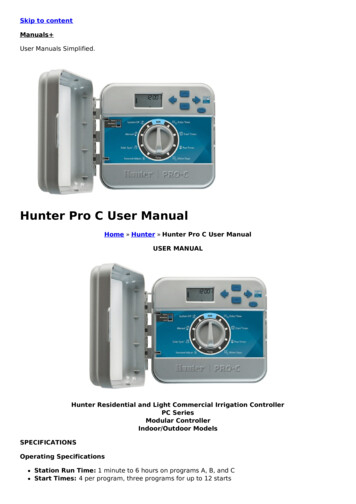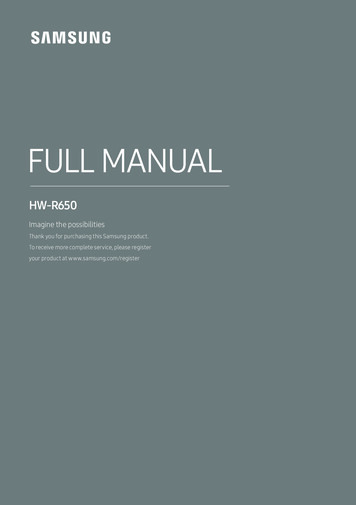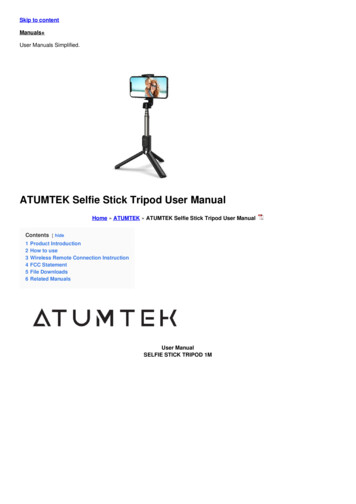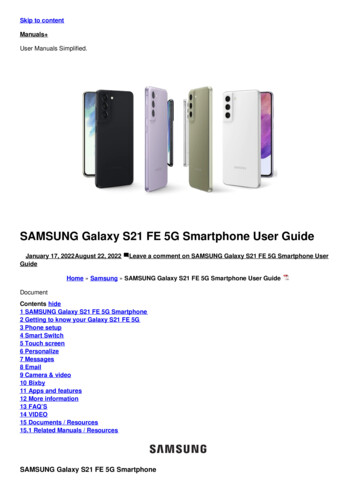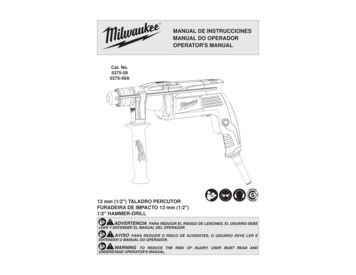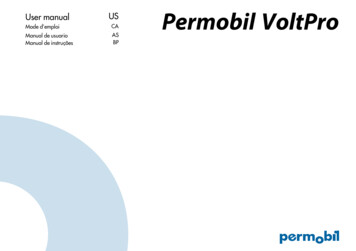
Transcription
User manualUSMode d’emploiCAManual de usuarioManual de instruçõesASBPPermobil VoltPro
Permobil VoltProUSProduced and published by PermobilEdition: 3Date: 2020-12-01Order no: 336651
American EnglishDear Permobil UserWe congratulate you on your choice of off-board battery charger. Our goalis for you to continue to feel satisfied with your choice of both vendor andproduct.Before you begin using your new off-board battery charger, it is importantthat you read and understand the contents of these operating instructions,and in particular the safety instructions.
American English
American EnglishHow to contact PermobilTel.:Fax:E-mail:Permobil Inc.300 Duke DriveLebanon, TN 37090USA 1 800 736 0925 1 800 231 3256support@permobil.comWeb:www.permobil.comHead office of the Permobil groupTel.:Fax:Permobil ABPer Uddéns väg 20861 36 TimråSweden 46 (0)60 59 59 00 46 (0)60 57 52 50E-mail:info@permobil.comWeb:www.permobil.com
American entsIntroduction . 8Warranty .8Standards and regulations .9Technical support .9Reporting incidents .9Scrapping and recycling.9Scope of delivery.10Safety.11Types of warning signs .11Warnings and precautions .12Labels and symbols.17Operation.19Charging instructions .19LED lights .20Charging tips.214Troubleshooting .225Technical specifications .235.15.25.35.4Electrical specifications.23Material, dimensions, weight.24Operating conditions .24Storage and shipping conditions.25
American English1IntroductionThis user manual contains important safety and operating instructions foryour off-board battery charger, model numbers 616270 & 616347.This product is intended for use with Permobil’s power wheelchairs. It isnot intended for use by children without supervision, including cleaningand maintenance of the product. It is not a toy for children to play with.Please read and follow all instructions and warnings in all manuals suppliedwith your power wheelchair and its accessories. Incorrect use may bothinjure the user and damage the wheelchair. In order to reduce these risks,thoroughly read the user manual and all manuals supplied, in particular thesafety instructions, their warning texts, and cautionary markings beforeusing these products.If this product is to be used by persons that lack experience or knowledgeof this type of product, or by persons with reduced physical, sensory, ormental capabilities, then these users must either be instructed on the usageof this product or be under supervision while it is being used.All information, pictures, illustrations and specifications are based upon theproduct information available at the time these operating instructions werecreated. Pictures and illustrations used in these operating instructions arerepresentative examples and not intended to be exact depictions of therelevant parts.We reserve the right to make changes to the product without prior notice.1.1WarrantyContact your dealer or Permobil Inc. USA for information about thewarranty period for this product.8Introduction
American EnglishIntroductionProduct Warranty Information sets forth the conditions of the warranty.For further information about applicable warranties, see dards and regulationsThis product fulfills the following requirements: The U.S. Food and Drug Administration’s regulation 21 CFR 820. The Underwriters Laboratories’ standard UL 1012. The Federal Communications Commission’s regulation codeFCC 47 CFR Part 15B. The Canadian Standards Association’s CSA C22.2 No.107.2–01. The ICES-003 standard of Innovation, Science and EconomicDevelopment Canada. Relevant subsections of the wheelchair standard series ISO-7176.1.3Technical supportIn the event of technical problems, contact your dealer or call PermobilInc. USA at 1-800-736-0925.1.4Reporting incidentsIf an incident occurs, please contact Permobil by phone or e-mail.1.5Scrapping and recyclingContact Permobil for information about scrapping agreements in force.9
American English1.6IntroductionScope of deliveryIncluded in this delivery is off-board battery charger , charging connectorholder and screw to attach the charging connector holder. The plugshown on power cable is an example. The actual plug will correspond tothe requirements of your market. Charging connector will connect toyour power wheelchair.1.6.1 The charging connector holderYou can attach charging connector holder to the housing of batterycharger with screw using an appropriate tool. Then chargingconnector can be inserted into charging connector holder betweencharging sessions.If you have trouble attaching the charging connector holder, ask yourservice technician to do this for you.Figure 1. Overview10
American English2SafetySafetyImportant safety instructions. Save these instructions.2.1Types of warning signsThe following types of warning signs are used in this manual:WARNING!Indicates a hazardous situation which, if not avoided, could result inserious injury or death as well as damage to the product or other property.CAUTION!Indicates a hazardous situation which, if not avoided, could result indamage to the product or other property.IMPORTANTIndicates important information.11
American English2.2Warnings and precautionsWARNING!Explosive gasesThe battery can emit explosive gases while charging. Do not expose toflames and sparks. Provide adequate ventilation during charging.Disconnect the charger from the power outlet before connecting ordisconnecting the battery. Read the instructions before charging.WARNING!Acid leakageMake sure that the battery charger setting matches the type of batteries thatare installed in your power wheelchair. If the wrong charger setting isused, the batteries can be exposed to overcharging which increases therisk of overheating. If the batteries overheat, they can leak hydrogen gasand acid.12Safety
American EnglishSafetyWARNING!High voltage shockFor indoor use only. If the charger is exposed to rain, you can get a highvoltage shock.WARNING!High voltage shockDo not place the charger in direct sunlight while charging. If you do, thiscan cause degradation of the plastic housing which increases the risk ofbreakage. If the plastic breaks, this can expose electric parts and give youa high voltage shock.WARNING!High voltage shockDo not allow the power plug to become wet and do not expose thecharger to excessive amounts of water. If you do, you can experience ahigh voltage shock.13
American EnglishWARNING!Incompatible with non-rechargeable batteriesOnly charge lead acid rechargeable batteries with your battery charger. Ifyou charge non-rechargeable batteries with your battery charger, thebatteries can explode and cause bodily harm.WARNING!Overheated battery chargerDo not cover the charger. If you do, the charger can become overheatedwhich can damage the charger and/or melt the plastic housing. If thehousing becomes damaged the electronics can become exposed andgive you a high voltage shock.WARNING!Overheated battery chargerIf the charger becomes overheated, you can get burned.14Safety
American EnglishSafetyWARNING!Check for damaged partsBefore each use, check that the battery charger and its cables and contactsare not damaged. Do not use a damaged charger. If you do, you canexperience a high voltage shock.CAUTION!Care and maintenanceService and other work on the battery charger should be carried out byqualified service technicians. In case of doubt, always contact a qualifiedservice technician or Permobil. Faulty service can cause the function andsafety of the product to deteriorate.Only use spare parts approved or recommended by Permobil. Failure todo so can lead to changes that can impair the function and safety of theproduct. It can also void the warranty.15
American EnglishIMPORTANTIncorrect voltage supplyOnly connect the battery charger to a power outlet with the recommendedvoltage. If the charger is connected to the incorrect voltage supply, e.g.when travelling between countries, the wheelchair cannot be charged.IMPORTANTTransporting the chargerDo not transport this off-board battery charger on your power wheelchair. Ifyou do, the vibrations that occur during driving can negatively affect yourcharger’s performance.16Safety
American English2.3SafetyLabels and symbolsInformation shown on the warning label:Item number:The internal Permobil itemnumber including revisionnumber.S/N:The product’s serial number.Input:The operating voltage that thebattery charger needs to function.Output:The power output produced bythe charger.Battery:The battery capacity and types thatthis charger is compatible with.Battery charger BFP:The battery charger has backfeedprotection.Special application:This product is defined as a specialapplication according to section6.24 of the UL 1012 standard.Permobil Inc.:The manufacturer’s address.Figure 2. An example of the warning label.17
American EnglishSymbol on the warning label:SafetyMeaning of the symbol:Read the instructions manualCautionCanadian Standards AssociationsymbolRecycling symbolThe assignment of the charging connector pins must be as shown:1. Positive2. Negative3. Inhibit (tied to negative)Figure 3. The charging connector pins.18
American English3OperationOperationA discharged battery should become fully charged in approximately 12hours. Results can vary depending on the size of your battery and howmuch charge is left in your battery when you start charging.Occasional use of the wheelchair prior to full charge is acceptable if theneed is urgent.3.1Charging instructionsTo charge your power wheelchair:1. Connect the charging connector of the battery charger to thewheelchair.2. Connect the power cable from the battery charger to a suitable poweroutlet.When charging is complete:1. Disconnect the battery charger’s power cable from the power outlet.2. Disconnect the charging connector from your wheelchair.19
American English3.2OperationLED lightsIf the battery charger is correctly connected to a power outlet: LED will illuminate green. LEDs , , and will flash during the battery charger’s start-up andthen they will turn off until the batteries begin charging. The number oftimes the LEDs flash indicate the charger setting. If the LEDs flash once,the charger is set for Permobil AGM GEL batteries. If the LEDs flashthree times, the charger is set for MK GEL batteries.While the batteries are charging, the LEDs , , and will illuminate asdescribed below: When LED illuminates yellow, it means that the batteries are emptyand are being charged. When LEDs and illuminate yellow, it means that the batteries arecharged more than 50%. If LEDs and are flashing yellow, it means that there is an error. Seechapter 4 Troubleshooting, page 22. When LED illuminates green in addition to LEDs and thatilluminate yellow, it means that the batteries are fully charged.20Figure 4. LED lights showing the battery levels.
American English3.3OperationCharging tipsHere are some recommendations that will help you reduce charging time,extend the life of your batteries, and maximize your wheelchair’sperformance: Always charge the batteries at room temperature in a well-ventilatedarea. Make sure that the battery charger setting matches the type of batteriesthat are installed in your power wheelchair. If possible, leave your power wheelchair connected to the batterycharger and a power outlet after the batteries are fully charged. Theautomatic functions within the battery charger will ensure that thebatteries are properly maintained.If the wheelchair is used daily or several times per week: Regardless of how much the wheelchair has been used each day, youshould always fully charge the batteries. To estimate the battery charging state, check the levels shown on thecontrol panel’s battery charge indicator or use the MyPermobil app. Formore information about MyPermobil, go to http://myp.permobil.com/If the wheelchair will be stored for more than two weeks: Before placing the power wheelchair in storage, charge the batteriesfully and then turn off the wheelchair’s circuit breaker. See thewheelchair’s user manual for further information. At least once every month, fully charge the batteries for optimalmaintenance of the batteries.21
American English4TroubleshootingTroubleshootingError indicationLEDsLEDandare flashing.does not illuminate.Only LED illuminates while thebattery charger is connected to thewheelchair and a power outlet.Possible causeRemedyError during charging.Try charging again. If the error persists,contact Permobil.The battery charger has overheated.Disconnect the charger and let it cooldown.Not connected to a power outlet.Check the power cable.Main power failure.Check the mains in your house.The battery charger has an internal error.Contact Permobil for repair.The battery charger does not detect thewheelchair’s batteries.Check that the charging connector isproperly connected to the wheelchair.Check the wheelchair’s main circuitbreaker. See the wheelchair’s user manualfor further information.Contact Permobil for repair.22
American English55.1Technical specificationsTechnical specificationsElectrical specificationsElectrical specificationsOutput current10 A 8%Output voltage24 V DC nominal (2x12 V batteries)Mains input nominal voltage range120 V AC, 60 HzInput voltage tolerance range110—126 V AC, 57—63 HzMaximum output power300 W (10 A)Insulation classClass IITemperature compensaton of charge voltageYesEfficiency (at 300 W load, input 120 V AC) 88%Approved battery capacity range(C20–capacity) 30—100 Ah(C5–capacity) 26—85 AhDielectric withstanding voltage3750 V AC, 50 HzApproved battery typesLead acid (Gel / AGM) (24 V)CoolingConvention cooling / fanless operation23
American English5.2Technical specificationsMaterial, dimensions, weightMaterial, dimensions, weightHousing materialPC / ABSHousing width206 mm (8.11")Housing height251 mm (9.88")Housing depth109 mm (4.29")Power cable length1800 mm (70.87")Charging cable (XLR) length2000 mm (78.74")Product weight1.4 kg (3.09 lb.)5.3Operating conditionsOperating conditionsAmbient temperature-10 C to 50 C ( 14 F to 122 F)Relative humidity10% to 90%, non-condensingAtmospheric pressure795 to 1060 hPa24
American English5.4Technical specificationsStorage and shipping conditionsStorage and shipping conditionsAmbient temperature-40 C to 65 C (-40 F to 149 F)Relative humidity0% to 93%, non-condensingAtmospheric pressure795 to 1060 hPa25
Permobil VoltProCARéalisé et publié par PermobilVersion: 3Date: 2020-12-01No de commande: 336651
Français canadienCher utilisateur de PermobilNous vous félicitons pour votre choix de chargeur de batterie externe.Nous nous attachons à ce que vous demeuriez satisfait de votre choix defournisseur et de produit.Avant de commencer à utiliser votre nouveau chargeur de batterie externe,il est important de lire et de bien comprendre le contenu de ce moded'emploi, en particulier les consignes qui se rapportent à la sécurité.
Français canadien
Français canadienComment contacter PermobilTél. :Télécopieur :Permobil Inc.300 Duke DriveLebanon, TN 37090USA 1 800 736 0925 1 800 231 3256Courriel :support@permobil.comSite Web :www.permobil.comSiège social du groupe PermobilTél. :Télécopieur :Permobil ABPer Uddéns väg 20861 36 TimråSverige 46 (0) 60 59 59 00 46 (0) 60 57 52 50Courriel :info@permobil.comSite Web :www.permobil.com
Français le des matièresIntroduction .32Garantie .33Normes et réglementations .33Soutien technique .33Signalement d'incidents.34Mise au rebut et recyclage .34Contenu de la livraison.34Sécurité .35Types de symbole d’avertissement .35Avertissements et précautions .36Étiquettes et symboles.41Utilisation.43Consignes de charge .43Voyants DEL .44Conseils de charge .454Dépannage.465Caractéristiques techniques.475.15.25.35.4Caractéristiques électriques.47Matériau, dimensions, poids .48Conditions de fonctionnement .48Conditions de stockage et d'expédition .49
Français canadien1IntroductionLe présent manuel d'utilisation contient des instructions de sécurité etd'utilisation importantes pour votre chargeur de batterie externe,modèles 616270 et 616347.Ce produit est destiné à être utilisé avec les fauteuils roulants électriquesPermobil. Il n'est pas destiné à être utilisé par des enfants sans surveillance, ycompris lors du nettoyage et de l'entretien. Ce n'est pas un jouet avec lequelles enfants peuvent jouer.Veuillez lire et respecter l'ensemble des directives et des avertissementsénoncés dans tous les manuels fournis avec votre fauteuil roulant électriqueet ses accessoires. Une utilisation erronée peut comporter des risques deblessure pour l'utilisateur et endommager le fauteuil roulant. Pour réduireces risques, lisez attentivement le manuel d'utilisation et tous les manuelsfournis, en particulier les consignes de sécurité, leurs textes d'avertissementet les marquages de mise en garde avant d'utiliser ces produits.Si ce produit est destiné à être utilisé par des personnes qui manquentd'expérience ou de connaissances sur ce type de produit ou par despersonnes dont les capacités physiques, sensorielles ou mentales sontréduites, ces utilisateurs doivent être formés à l'utilisation de ce produit ouêtre sous surveillance pendant son utilisation.Les renseignements, les photos, les illustrations et les caractéristiquestechniques correspondent aux données disponibles sur le produit aumoment de la création de ce manuel. Les photos et les illustrationsreproduites dans ce mode d'emploi ne sont données qu'à titre d'exemples etne doivent pas être considérées comme la représentation exacte deséléments concernés.32Introduction
Français canadienIntroductionNous nous réservons le droit d'apporter des modifications au produit sansaucun préavis.1.1GarantieVeuillez contacter votre revendeur ou Permobil Inc. (É.-U.) en ce quiconcerne la période de garantie de ce produit.Les Renseignements sur la garantie de produit énoncent les conditions de lagarantie. Pour en savoir davantage sur les garanties applicables, /.1.2Normes et réglementationsCe produit répond aux exigences des documents suivants : Le règlement de la FDA des États-Unis 21 CFR 820. La norme Underwriters Laboratories UL 1012. Le code de réglementation de la Commission fédérale descommunications (FCC), titre 47 du CFR, partie 15B. La norme de l'Association canadienne de normalisation(CSA) C22.2 n 107.2-01. Norme ICES-003 pour l' innovation, la science et le développementéconomique au Canada. Les sous-sections correspondantes de la série de normes pour fauteuilsroulants ISO-7176.1.3Soutien techniqueEn cas de problèmes techniques, veuillez contacter votre revendeur ouappelez Permobil Inc. (É.-U.) au 1-800-736-0925.33
Français canadien1.4IntroductionSignalement d'incidentsSi un incident se produit, veuillez communiquer avec Permobil partéléphone ou par courriel.1.5Mise au rebut et recyclageVeuillez contacter Permobil pour ce qui concerne les accords de mise aurebut en vigueur.1.6Contenu de la livraisonCe kit comprend un chargeur de batterie sur support séparé , un supportde connecteur de charge et une vis pour fixer le support deconnecteur de charge. La fiche illustrée sur le câble d'alimentation est unexemple. La prise réelle correspondra aux exigences de votre marché. Leconnecteur de charge se connectera à votre fauteuil roulant électrique.1.6.1 Le support de connecteur de chargeVous pouvez fixer le support de connecteur de charge sur le boîtier duchargeur de batterie à l'aide d'une vis en utilisant un outil approprié.Le connecteur de charge peut ensuite être inséré dans le support deconnecteur de charge entre les séances de charge.Si vous rencontrez des difficultés pour fixer le support du connecteur decharge, demandez à votre technicien de maintenance de le faire pour vous.Illustration 5. Aperçu34
Français canadien2SécuritéSécuritéConsignes de sécurité importantes. Conservez ces instructions.2.1Types de symbole d’avertissementLes types de symboles d’avertissement suivants sont utilisés dans ce manuel :ATTENTION!Indique une situation périlleuse qui, si elle n'est pas évitée, peut entraînerdes blessures graves ainsi que des dommages au produit ou à d'autresbiens.PRUDENCE!Indique une situation périlleuse qui, si elle n'est pas évitée, peut entraînerdes dommages au produit ou à d'autres biens.IMPORTANTIndique des renseignements importants.35
Français canadien2.2Avertissements et précautionsATTENTION!Gaz explosifsLa batterie peut émettre des gaz explosifs pendant la recharge. N'exposezpas la batterie à des flammes ou à des étincelles. Assurez une aérationadéquate pendant la recharge. Débranchez le chargeur de l'alimentationélectrique avant de connecter ou de déconnecter la batterie. Lisez lesinstructions avant la recharge.ATTENTION!Fuite d'acideAssurez-vous que le réglage du chargeur de batterie correspond au typedes batteries installées dans votre fauteuil roulant électrique. Un mauvaisréglage du chargeur peut entraîner une surcharge des batteries, ce quiaugmente le risque de surchauffe. Si les batteries surchauffent, ellespeuvent laisser échapper de l'hydrogène et de l'acide.36Sécurité
Français canadienSécuritéATTENTION!Choc haute tensionPour un usage à l'intérieur seulement. Si le chargeur est exposé à la pluie,vous pouvez recevoir un choc haute tension.ATTENTION!Choc haute tensionN'exposez pas le chargeur à la lumière directe du soleil pendant lacharge. Le non-respect de cette consigne peut entraîner une dégradationdu boîtier en plastique, ce qui augmente le risque de rupture. Si leplastique se rompt, cela peut exposer les pièces électriques et provoquerun choc de haute tension.ATTENTION!Choc haute tensionNe laissez pas la prise de courant se mouiller et n'exposez pas le chargeurà des quantités d'eau excessives. Le non-respect de cette consigne peutentraîner un choc de haute tension.37
Français canadienATTENTION!Incompatible avec les batteries nonrechargeablesChargez uniquement les batteries plomb-acide rechargeables avec votrechargeur de batterie. Si vous chargez des batteries non rechargeablesavec le chargeur, celles-ci peuvent exploser et causer des blessurescorporelles.ATTENTION!Chargeur de batterie surchaufféNe couvrez pas le chargeur. Si vous ne respectez pas cette consigne, lechargeur peut surchauffer, ce qui peut endommager le chargeur ou fairefondre le boîtier en plastique. Si le boîtier est endommagé, les composantsélectroniques risquent d'être exposés et de provoquer un choc de hautetension.ATTENTION!Chargeur de batterie surchaufféEn cas de surchauffe du chargeur, vous pouvez vous brûler.38Sécurité
Français canadienSécuritéATTENTION!Recherchez les pièces endommagéeséventuellesAvant chaque utilisation, vérifiez que le chargeur de batterie, ses câbles etses contacts ne sont pas endommagés. N’utilisez pas de chargeur debatterie endommagé. Le non-respect de cette consigne peut entraîner unchoc de haute tension.PRUDENCE!Entretien et maintenanceL'entretien et toutes autres réparations du chargeur de batterie doivent êtreeffectués par un technicien de maintenance qualifié. En cas de doute,contactez toujours un technicien de maintenance qualifié ou Permobil. Unentretien fautif peut entraîner une détérioration du fonctionnement et de lasécurité du produit.N'utilisez que des pièces détachées approuvées ou recommandées parPermobil. Le non-respect de cette consigne peut entraîner des modifications susceptibles d'altérer le fonctionnement et la sécurité du produit. Celapeut également annuler la garantie.39
Français canadienIMPORTANTTension d'alimentation incorrecteBranchez le chargeur de batterie uniquement sur une prise de courant à latension recommandée. Si le chargeur est branché sur une alimentationélectrique incorrecte, p. ex. lors d'un déplacement entre des pays, lefauteuil roulant ne peut pas être chargé.IMPORTANTTransport du chargeurNe transportez pas ce chargeur de batterie externe sur votre fauteuilroulant électrique. Si vous ne respectez pas cette consigne, les vibrationsqui se produisent pendant la conduite peuvent nuire aux performances devotre chargeur.40Sécurité
SécuritéFrançais canadien2.3Étiquettes et symbolesInformations figurant sur l'étiquette d'avertissement :Item number:Le numéro d'article Permobilinterne, y compris le numéro derévision.S/N:Le numéro de série du produit.Input:La tension de fonctionnement
American English How to contact Permobil Permobil Inc. 300 Duke Drive Lebanon, TN 37090 USA Tel.: 1 800 736 0925 Fax: 1 800 231 3256 E-mail: support@permobil.com Web: www.permobil.com Head office of the Permobil group Permobil AB Per Uddéns väg 20 861 36 Timrå Sweden Tel.: 46 (0)60 59 59 00 Fax: 46 (0)60 57 52 50 E-mail: info@permobil.com
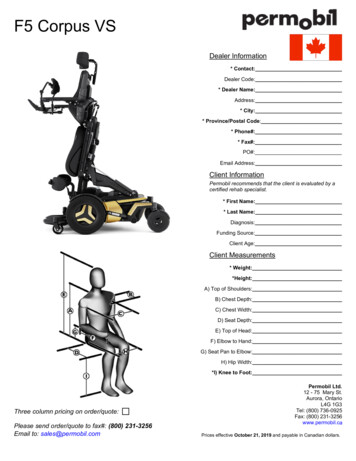


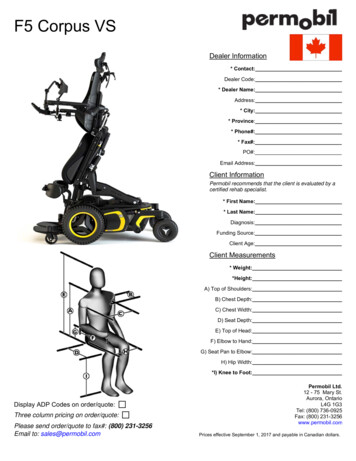
![INDEPENDENCE WITH ACTIVITIES OF DAILY LIVING, etc.] he . - Permobil](/img/54/8-20-15-f5vs-lmn.jpg)
